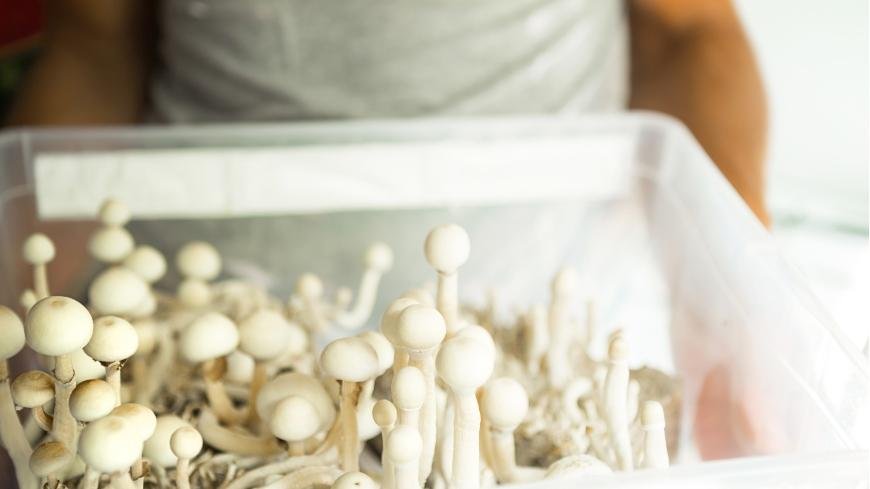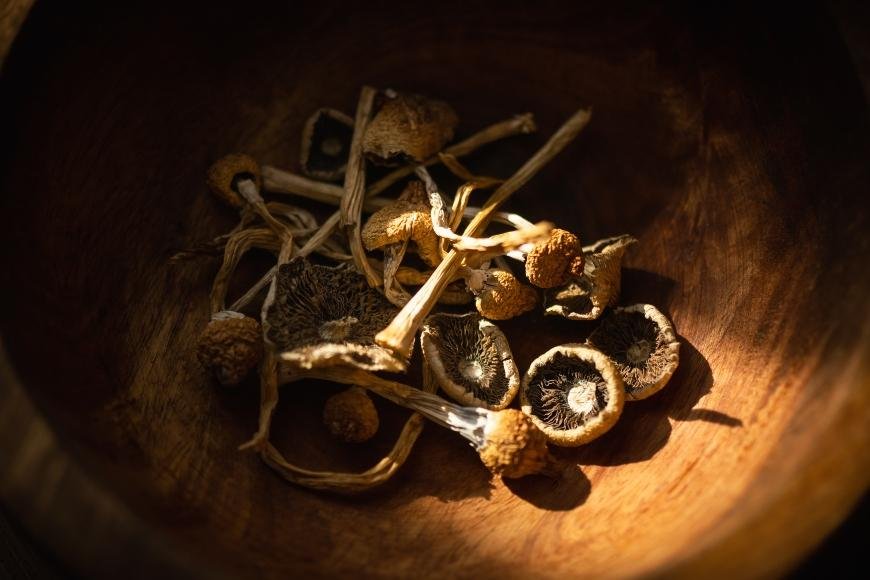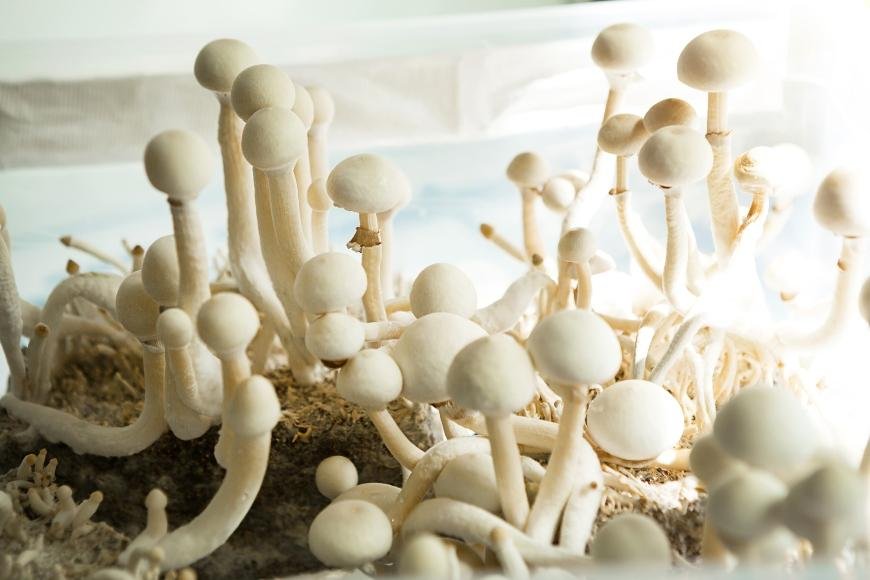Grow Your Own Magic Mushrooms
Learn how to cultivate your own magic mushrooms safely and responsibly! From understanding the basics of mushroom cultivation to harvesting and storing, we'll show you everything you need to know.

Magic mushrooms have been used for centuries in spiritual and medicinal practices, but recently they've become more widely available. Harnessing the power of these mysterious mushrooms for yourself is possible with a bit of knowledge and dedication - let us show you how. From understanding the basics of mushroom cultivation to preparing a grow space, choosing the right substrate, optimizing conditions for growth, harvesting your crop and storing it properly - there's much to learn about cultivating these fascinating fungi. Let us guide you through this process so that you can enjoy homegrown magic mushrooms safely and responsibly.
Table of Contents:
- Understanding Magic Mushrooms
- Growing Magic Mushrooms at Home
- Preparing Your Grow Space
- Choosing the Right Substrate
- Optimizing Conditions for Growth
- Harvesting Your Magic Mushrooms
- Storing Your Magic Mushrooms
- FAQs in Relation to Magic Mushrooms
- Conclusion
Understanding Magic Mushrooms
Magic mushrooms, also known as psilocybin mushrooms, are a type of mushroom that contains the psychoactive compound psilocybin. For centuries, indigenous cultures in Central and South America have utilized psilocybin mushrooms for spiritual and medicinal purposes.
With over 180 varieties of magic mushrooms, ranging from mild to intense in their effects and cultivation difficulty, Psilocybe cubensis is a popular choice for its strong psychedelic properties. Psilocybe cubensis, renowned for its powerful psychedelic effects and straightforward cultivation process, is a favourite among the 180+ species of magic mushrooms. Other varieties include Panaeolus cyanescens, Copelandia cyanescens, Gymnopilus spectabilis, Inocybe aeruginascens, Pluteus salicinus and many more.
The active compounds found in magic mushrooms can produce intense visual hallucinations as well as changes in perception, such as an altered sense of time or space. The intensity of these effects depends on the amount taken as well as the user’s tolerance level. For those unfamiliar with magic mushrooms, it is advisable to begin at a low dose in order to avoid potential adverse effects such as anxiety or panic attacks.
Gaining insight into Magic Mushrooms can be a daunting task, yet with the right education and direction, it is possible to acquire an appreciation of them. With that knowledge in hand, growing Magic Mushrooms at home becomes much more feasible.
Growing Magic Mushrooms at Home
Growing magic mushrooms at home is a fun and rewarding experience. But it’s important to understand the basics of cultivation before you get started. The first step is understanding what type of substrate will work best for your specific species of mushroom. Different types of substrates are available, from straw and sawdust to manure or composted materials. Once you’ve chosen the right substrate, you need to prepare your grow space in order to optimize conditions for growth. This includes selecting an appropriate container, providing ventilation, regulating temperature and humidity levels, and maintaining adequate light exposure.
Next comes inoculation:
introducing spores into the substrate so that they can begin growing mycelium (the vegetative part of fungi). Inoculating with spores requires a sterile technique in order to avoid contamination from other microorganisms that could inhibit growth or even cause health problems if consumed later on down the line. You may also want to consider adding supplemental nutrients such as fish emulsion or molasses during this stage in order to boost yields when harvesting time comes around.
Once the mycelium has colonized most (or all) of the substrate material it’s time for fruiting. Here again, environmental conditions play a key role; temperatures should be between 60-70°F (15-21°C), relative humidity should remain high (~85%), and air exchange needs to be frequent but not too strong—all these factors help encourage pinning which leads directly into harvesting your mushrooms. When harvesting your crop, make sure you do so gently using clean tools like scissors or tweezers; this helps prevent damaging delicate structures within each mushroom cap while also avoiding any potential contamination issues down the road when storing them away for future use/consumption.
Finally, once harvested, it is important to store them properly by drying out excess moisture content until they become brittle enough that they won't spoil quickly due to their decreased water activity level. This ensures maximum shelf life without sacrificing quality over time. With proper storage techniques, one can easily enjoy their homegrown bounty for a much longer period of time than expected; having access to fresh shrooms anytime is certainly an added bonus.
Growing magic mushrooms at home is a rewarding experience that can provide you with an abundance of these fascinating fungi. Now, it's time to prepare your grow space for the best possible results.
Preparing Your Grow Space
For magic mushroom cultivation, it is essential to bear in mind certain fundamental considerations when setting up the growth area. To ensure sterility, it is essential to take precautions such as wearing gloves when dealing with materials, sanitizing surfaces with a bleach or alcohol solution and avoiding any kind of foreign matter like dust or pet fur. This means using gloves when handling materials, cleaning surfaces with alcohol or bleach solution before use, and avoiding any kind of contaminants like dust or pet hair. Ensure that the space for cultivation is well-ventilated to enable a flow of fresh air.
Temperature is also important when growing magic mushrooms. The optimal temperature for growing magic mushrooms is between 20-26°C (68-78°F). Excessive warmth can be fatal to the mycelium, while insufficient heat will cause a major slowdown in its growth rate. You'll want to monitor temperatures closely during this process since even small fluctuations can have a big impact on mushroom growth rates.
Humidity levels should remain consistent throughout the entire growing cycle of magic mushrooms; ideally, they should stay around 70%. To ensure this level of humidity stays constant, you may need an additional humidifier in order create a more controlled environment inside your grow space if necessary - especially during dry seasons or climates where humidity levels naturally fluctuate quite drastically over short periods of time
Creating the optimal atmosphere for your fungi is an integral part of cultivating magic mushrooms, as it will guarantee that they have all the necessary components to prosper. Now that you have a suitable environment, it's time to select the right substrate for your mushroom growth.

Choosing the Right Substrate
The choice of substrate for cultivating magic mushrooms is a key determinant in achieving success. It's essential to identify the substrates that best suit your requirements, as each substrate offers its own advantages and disadvantages.
Coco Coir:
Coco coir is a popular choice among mushroom growers because of its affordability and ease of use. Coco coir is created from ground coconut husks and mixed with water to form a paste-like consistency, making it an ideal substrate for mushroom growth. The advantage of using coco coir as a substrate is that it retains moisture well while also providing good air flow around the mycelium (the root structure), allowing for faster growth rates. Coco coir is also suitable for a variety of fungal species, including those that produce psilocybin.
Vermiculite makes an ideal substrate for magic mushrooms as it locks in moisture, facilitates good airflow around the mycelium, helps maintain stable temperatures and reduces contamination risks. It's not easily contaminated by spores compared to substrates such as straws or sawdust which must be properly sterilized before use. Vermiculite proves a wise choice for those looking to get their mushroom-growing off on the right foot. Keywords: Magic Mushrooms, Substrate, Moisture Retention, Air Flow Around Mycelium.
Sawdust has been utilized as a primary component in mushroom cultivation for its abundance and affordability; however, it can be difficult to control temperature fluctuations within containers/bags which can lead to slower growth rates than those achieved using coco coir or vermiculites. Additionally, if not adequately sterilized before use, sawdust carries a higher risk of contamination resulting in failed crops near harvest time and even potential health risks. Although rare instances occur, these issues are worth noting when considering the use of sawdust as a substrate for magic mushrooms. Keywords: Magic Mushrooms, Substrate, Moisture Retention, Air Flow Around Mycelium
Optimizing the substrate is paramount for mushroom cultivation to be successful, as it gives sustenance and encourages vigorous mycelium development. Now that you have chosen your substrate, optimizing conditions for growth will help ensure the maximum yield of mushrooms.
Optimizing Conditions for Growth
Creating the perfect environment for your magic mushrooms to thrive in is essential for a successful harvest. Achieving the best atmosphere for your shrooms necessitates taking into consideration a variety of aspects, such as temp., moisture levels, light and bedding.
Temperature:
Magic mushrooms require temperatures between 65-80°F (18-27°C) during their growth cycle. If the temperature drops too low or rises too high, it can have an adverse effect on the mushroom’s development. It is important to monitor temperatures closely as fluctuations can occur quickly in certain environments.
Humidity:
High levels of humidity are needed for proper mushroom growth and development. The ideal range should be between 85-95%. To achieve the necessary humidity, one may need to utilize a humidifier or misting system, such as an ultrasonic fogger or cool mist humidifier, depending on your particular setup. This will help ensure optimal moisture levels throughout the growing process.
Light Exposure:
Mushrooms do not require direct sunlight but they do need some form of light exposure to promote healthy growth and development. A simple fluorescent lamp with a daylight bulb should provide enough light while avoiding any potential damage from UV rays which could kill off your crop prematurely if left unchecked.
Substrate Type:
The type of substrate used plays a major role in determining how well your mushrooms will grow and develop over time. Popular substrates include straw, wood chips, composted manure, vermiculite/perlite mixtures and even grain spawn bags, depending on what kind of mushroom you are trying to cultivate. It is essential to investigate which substrate best meets your requirements prior to beginning, as each one has its own specific characteristics.
Finally, airflow is also key when optimizing conditions for mushroom growth, as stagnant air can lead to mould issues down the line, which could ruin an entire batch if left unchecked. To ensure there is plenty of fresh air circulating around your grow space, use fans or other ventilation systems designed specifically for this purpose. This will help keep things running smoothly until harvest time arrives.
Optimizing conditions for growth is essential to the successful cultivation of magic mushrooms. With proper harvesting techniques, you can ensure that your mushroom yield will be plentiful and high-quality.

Harvesting Your Magic Mushrooms
Harvesting magic mushrooms is an important step in the cultivation process. Realizing the optimal moment and method for picking magic mushrooms is critical to maximizing your crop's yield.
Considering when to pick is a key factor. You should wait until the mushroom caps have opened up fully, and they are ready for harvesting. This usually takes between 5-7 days after pinning has occurred. Once you see a few of the mushrooms opening up, it’s time to start harvesting them one by one as soon as possible so that other mushrooms don't spoil or become over-mature before being harvested too.
When harvesting, employ a cutting instrument such as scissors or tweezers instead of plucking the mushrooms with your hands to prevent harm to both the substrate and nearby mycelium. Gently cut off each mushroom at its base near where it meets the substrate material, leaving some of its root structure intact, if possible, for future harvests down the line. Make sure not to touch any part of the mushroom itself with bare hands as this could contaminate it with bacteria or fungi, which may ruin its potency or quality when ingested later on down the road.
Once you've gathered the magic mushrooms, it's essential to store them in paper bags or cardboard boxes (avoid plastic) as soon as possible to preserve their freshness and protect against contamination. Put them in paper bags or cardboard boxes (avoid plastic) to protect against contamination from outside sources like air-borne spores. These containers will also help maintain their freshness until consumption; however, keep in mind that dried psychedelics usually have a longer shelf life than fresh ones do, so drying yours out might be wise if you want extended longevity for storage purposes. Keywords: Harvesting Magic Mushrooms, Storage Containers, Air-Borne Spores, Freshness Preservation, Longer Shelf Life
Harvesting your magic mushrooms requires careful attention to detail and timing. Knowledge of the correct methods is essential to guarantee a superior harvest. Once harvested, proper storage is essential to maintain the potency and freshness of your magic mushrooms.
Storing Your Magic Mushrooms
Storing your magic mushrooms is an important step in the process of harvesting and preserving them. If done correctly, you can enjoy your mushrooms for weeks or even months after they’ve been harvested. To ensure your mushrooms remain fresh for an extended period of time, proper storage techniques should be employed.
Keep Them Dry:
The key to storing magic mushrooms is keeping them dry. Moisture will cause mould and bacteria growth, which will quickly ruin your harvest. For optimal dryness, store the mushrooms in a paper bag or cardboard box with good airflow and wrap each one individually in parchment paper. You can also wrap each mushroom individually in parchment paper before placing it into the container.
Store at Room Temperature:
Magic mushrooms should be stored at room temperature between 50-70°F (10-21°C). Storing them outside this range could cause the spores to become inactive or spoil faster than normal.
If desired, refrigeration may be employed to maintain the potency of shrooms for up to two weeks; however, ensure that they are completely dry before storage in a sealed plastic bag. Ensure shrooms are dried out before putting them in a sealed plastic bag and stowing them away in the fridge; else, condensation can form, leading to spoilage.
Avoid Direct Sunlight:
Sunlight can damage active compounds within magic mushrooms, so make sure that any storage area is kept out of direct sunlight as much as possible. This includes areas like windowsills or countertops near windows where sunlight might leak through during certain times of the day.
Heat sources such as ovens, stoves and radiators should also be avoided when storing magic mushrooms since heat can degrade their potency over time, too – especially when temperatures exceed 70°F (21°C). Opting for dark cupboards away from any potential heat sources provides better insulation against both light and heat exposure while still allowing adequate airflow around the shrooms themselves.
Conclusion
In the end, for those prepared to expend energy and study, cultivating magic mushrooms can be a satisfying undertaking. With the right conditions and knowledge of how to grow them properly, you will have success with your own harvest of these fascinating fungi. Magic mushrooms can provide many benefits, from medicinal properties to spiritual enlightenment, when used responsibly; however, it is important that one has an understanding of their effects before attempting cultivation at home.




















































































































